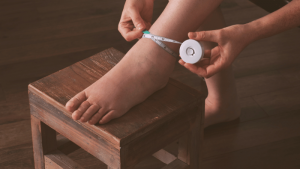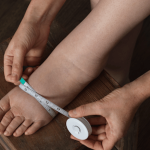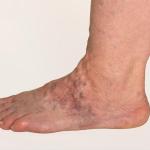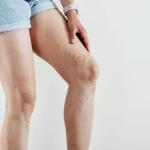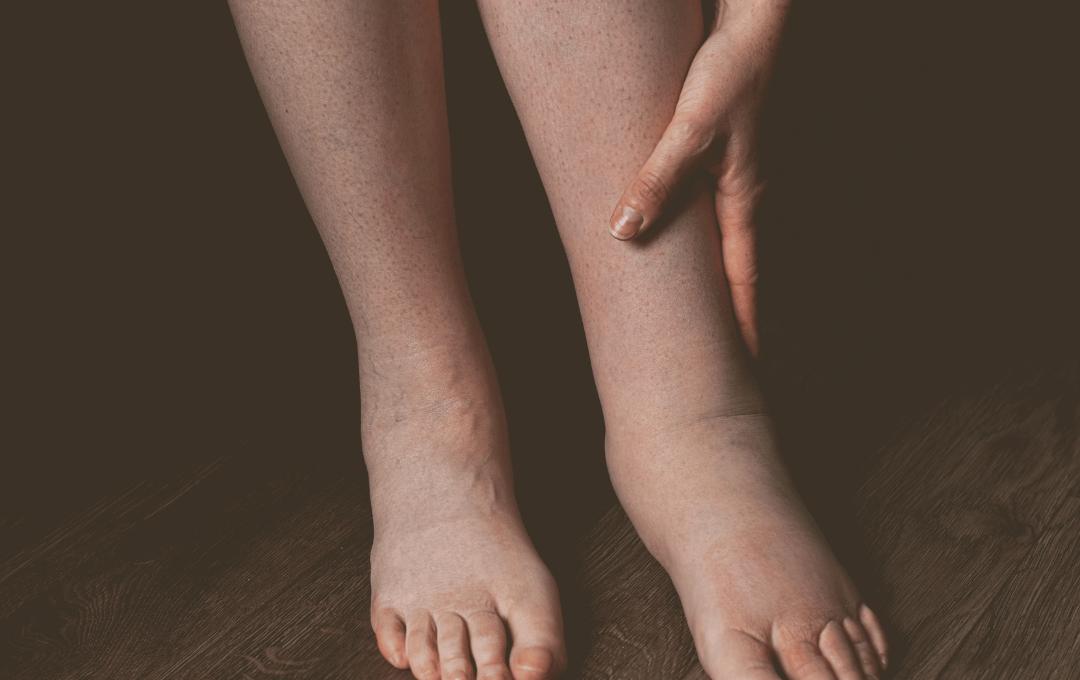
Swollen legs and feet in hot weather might seem harmless, but they could be a sign of heat edema, where our body retains fluid as a reaction to the heat. Leg swelling in hot weather is a common response to heat-induced fluid retention.
If you’ve noticed recurring swelling in your legs, it might be more than just the heat. Take our quick leg health quiz to determine if your symptoms could be related to a vein issue, and learn what steps you can take next.
Why Do My Legs Swell in the Heat?
Many people experience leg swelling in hot weather, especially after standing for long periods outdoors. This condition occurs when high temperatures cause blood vessels to dilate, leading to fluid accumulation in the lower extremities. While this process regulates body temperature, the veins must work harder to push blood back toward the heart, especially in the lower limbs.
Since the feet and legs are the farthest point from the heart, gravity and inefficient circulation can cause fluid to pool, especially when veins become more relaxed in the heat. This increased pressure in the legs contributes to heat edema.
What Causes Heat Edema in the Legs and Feet?
Heat edema occurs when the body struggles to regulate fluid balance in hot weather. One of the main causes of heat edema is the natural expansion of blood vessels in response to heat. As these vessels widen, fluid can leak into the surrounding tissues, particularly the legs and feet.
When sitting or standing for long periods, gravity pulls more fluid down toward the lower limbs, making the swelling more pronounced.
Other Heat Edema Risk Factors
Rising temperatures are the main cause of heat edema, but some risk factors may also contribute to the swelling, including:
Demographics
- Age: Aging veins and decreased circulation can increase the likelihood of fluid buildup, leading to heat edema in older adults.
- Pregnancy: Hormonal changes and pressure from the growing uterus can reduce blood flow, potentially leading to fluid accumulation.
- Premenstrual symptoms: Hormonal fluctuations during the menstrual cycle can lead to temporary water retention.
Lifestyle Factors
- Excessive salt intake: High levels of sodium in your diet can cause the body to retain water, leading to swelling.
- Prolonged sitting or standing: Remaining in one position for too long can reduce blood flow to the legs and increase fluid buildup.
Medications
- Blood pressure medications (e.g., calcium channel blockers): These types of medication can dilate veins, potentially leading to fluid leakage.
- Steroids, anti-inflammatories, and hormonal therapies: These medications can disrupt the body’s fluid balance, leading to water retention and swelling.
Medical Conditions
- Chronic venous insufficiency (CVI): Damaged vein valves can make it harder for blood to return to the heart, causing blood to pool, leading to swelling and the appearance of varicose or spider veins.
- Congestive heart failure, kidney or liver disease: These conditions affect the body’s ability to regulate fluid levels properly.
- Deep vein thrombosis (DVT): A blood clot in the deep leg veins can block blood flow, leading to sudden and painful swelling in one leg.
Common Symptoms of Heat Edema
Heat edema symptoms typically consist of noticeable swelling in the legs, ankles, or feet. One of the most visible signs of heat edema is puffiness in the affected areas, which may cause your skin to look stretched or shiny.
Other common heat edema symptoms may include:
- Skin that retains a dimple when pressed
- Heaviness in the legs
- Puffiness that worsens as the day goes on
- Difficulty walking due to swelling
When to Worry About Leg Swelling in the Heat
In most cases, heat edema is not dangerous, as it is usually temporary and resolves independently with simple interventions, such as resting, elevating the legs, staying hydrated, and cooling down. For many people, the swelling gradually subsides once the body adapts to the heat or moves into a cooler environment.
However, swelling should not be ignored if it becomes painful, persistent, or isolated to one leg. These could be signs of serious issues, such as chronic venous insufficiency—a condition where weakened vein valves in the legs make it harder for blood to flow back to the heart—or a blood clot requiring medical attention.
When Leg Swelling Could Signal a Vein Condition
Swelling accompanied by other symptoms may indicate a more serious condition. The following symptoms are signs that your edema or swelling might have different underlying causes:
- Varicose and spider veins
- Leg aching or pain
- Redness or skin irritation
- Heaviness or fatigue in the legs
- Cramping or “charley horses”
- Itching, burning, or restlessness in the legs
If you are experiencing any of the above symptoms, this may be a sign of chronic venous insufficiency, or vein disease. Vein disease can cause long-term circulation issues, leading to chronic swelling, discomfort, and potential complications if left untreated.
How to Treat Heat Edema and Reduce Swelling
To prevent swelling caused by heat and alleviate symptoms of heat edema, avoid hot temperatures, stay hydrated, and limit prolonged sitting or standing. If symptoms persist or worsen, seek medical attention.
Temporary Management Solutions for Heat Edema
If you’re experiencing heat edema in your legs or feet, there are several steps you can take to relieve swelling:
- Elevate your legs above heart level to help blood flow and reduce fluid buildup.
- Wear compression socks to gently squeeze the legs and minimize fluid pooling, especially if you’ll be standing or sitting for long periods.
- Stay cool and hydrated to regulate your body temperature and reduce fluid retention.
- Limit your salt intake, as salt consumption can exacerbate water retention in the legs.
These steps can provide temporary relief and help manage mild heat edema from becoming a more persistent issue.
Treatments for Leg Swelling in the Heat
If swelling persists, becomes painful, or is accompanied by other symptoms, such as leg heaviness or visible veins, it may indicate an underlying vein condition, such as chronic venous insufficiency (CVI). In such cases, consulting a vein specialist is advisable for an effective treatment plan.
USA Vein Clinics is a trusted national provider of minimally invasive vein treatments.
These treatments include:
- Endovenous Laser Therapy (EVLT)
- ClariVein®
- Varithena®
- VenaSeal™
- Radiofrequency Ablation (RFA)
- Ultrasound-Guided Sclerotherapy
- Visual Sclerotherapy
Our vein specialists offer expert diagnoses and personalized treatments to address the underlying cause of leg swelling and provide lasting symptom relief.
Don’t Ignore Persistent Leg Swelling in Heat
Sometimes, managing heat edema involves simple adjustments to lifestyle habits or medications. However, if symptoms continue or worsen, it may be a sign of vein disease and needs treatment to prevent complications from developing.
USA Vein Clinics offers a patient-centered approach to vein care. With over 168 locations nationwide, patients can find convenient relief from painful symptoms of vein disease, including edema. USA Vein Clinics participates with most major health insurance plans, and can ensure your treatment is covered after you schedule your appointment.
Find a vein specialist near you and take the first step toward relief and recovery today.
FAQs
Are Varicose Veins and Heat Edema Connected?
Heat edema and varicose veins are two conditions that can be interconnected, particularly in warmer climates. Heat edema in your legs can increase varicose vein symptoms, making them more noticeable, uncomfortable, and painful.
How Long Does it Take for Heat Edema to Go Away?
Heat edema, or swelling caused by excessive heat exposure, can persist for a few days or longer, depending on its severity.
If the swelling persists for longer than a week in addition to pain, aching, itching, or varicose and spider veins in the legs, or is accompanied by symptoms such as pain, redness, or fever, this may indicate an underlying medical condition.
Is it Normal for Only One Leg to Swell in the Heat?
Swelling in one leg in the heat can indicate a more serious underlying health issue, such as chronic venous insufficiency (CVI), lymphedema, or deep vein thrombosis (DVT). It’s important to seek medical attention to identify the cause of the swelling and receive appropriate treatment.
Can Heat Edema be Prevented?
Heat edema can often be prevented by minimizing heat exposure, staying hydrated, limiting salt intake, and engaging in regular physical activity. These measures can help reduce your risk of developing heat-related swelling. However, if swelling persists for longer than a week, it’s recommended to seek medical consultation.
Medically Reviewed By:
Dr. Yan Katsnelson is a philanthropist, business owner, and highly skilled cardiac surgeon. He is the Founder and CEO of USA Vein Clinics, which is part of USA Clinics Group, the parent company of USA Fibroid Centers, USA Vascular Centers, and USA Oncology Centers, with more than 100 facilities nationwide. Dr. Yan has established himself as a strong advocate for accessibility and affordability of the most advanced medical care close to home. His mission is to create a positive experience for each patient with compassionate, personalized, and expert care.

